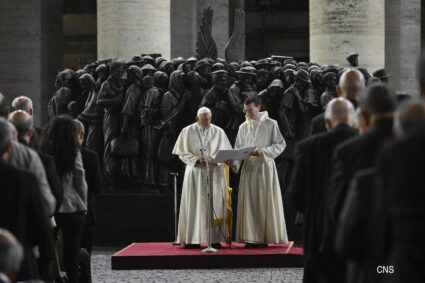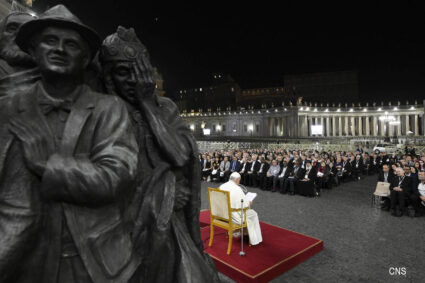Hello and welcome,
In recent weeks and months, we have been in consultation with the Healey-Driscoll Administration regarding the significant influx of immigrants to the Commonwealth. Presently, there are 7,000 families being cared for in state-sponsored shelters (approximately 20,000 individuals); by October 31st, the expectation is that 7,500 families will be with us. In fact, the Archdiocese, through Catholic Charities, St. Mary’s Center for Women and Children and the Archdiocesan Planning Office for Urban Affairs, has worked closely with the Healey-Driscoll Administration and with other non-profit agencies ever since the flow of immigrants has increased geometrically in the last few months. All three of those agencies have expanded capacity to meet both the short and long-term needs for housing and supportive services.
In the coming days, we will be reaching out to our parishes and ministries with suggested immediate steps they can take to assist us in meeting basic needs for immigrants during this time of great demand.
We continue to have broad conversations with the Governor and Lt. Governor on a number of potential ways we can assist during this time of crisis. This endeavor is in line with the social justice teaching of the Church. Pope Francis has said that in migrants, we are not only seeing our brother or sister seeking refuge, “but Christ Himself, who knocks at our door.”
Our work at the synod continues. Since my last post, we have been discussing the themes of Models B2 and B3 of the Instrumentum laboris.
Here you can see the Holy Father presiding one day at the Synod.
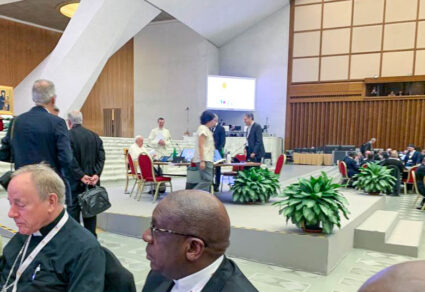
Next to him is standing one of the Camaldolese monks who lead the singing for our prayers every day.
Each Saturday in October, we are having rosary processions praying for the synod. This time, it was led by Cardinal Beniamino Stella, the retired cardinal who was the prefect of the Congregation for the Clergy for many years.
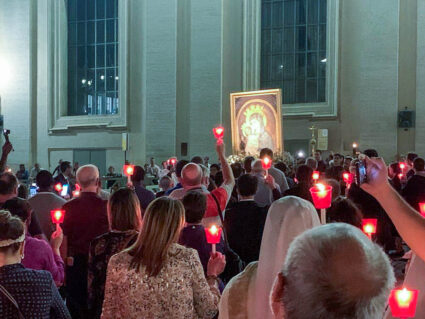
It was a very beautiful procession attended by thousands of people.
On Sunday, I celebrated a Mass at my titular church, Santa Maria della Vittoria, for the Feast of St. Teresa of Avila.
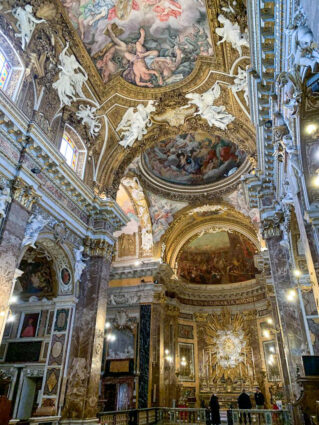
The church has been in the care of the Carmelite Friars for many years, but the friars are going to move to their generalate. Taking their place is a community of young, active Carmelite Sisters from Brazil. They sang for us at the Mass.
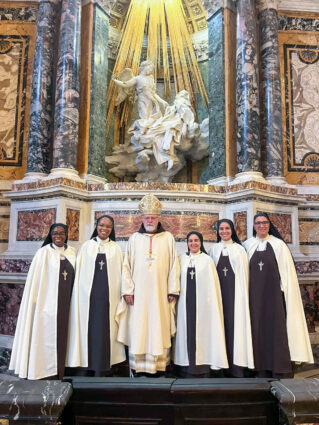
Joining us at the Mass was Bishop Peter Uglietto, who is in Rome participating in the ongoing formation program at the North American College. We were also accompanied by Father Antonio Nardoianni, the former pastor at St. Leonard’s Parish in North End. He’s now stationed at the Immaculate Conception Province’s formation house in Rome, Convento San Francesco. They have several vocations, particularly from Latin America, where the province has missions.
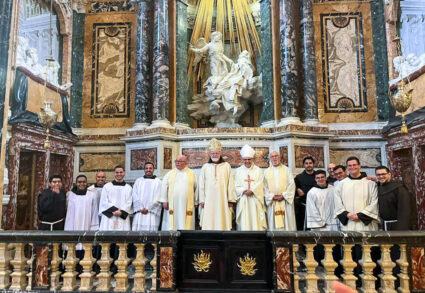
Father Antonio brought the brothers from his monastery to serve the Mass.
Of course, the synod has brought together people from all over the world. Among those I ran into this past week was the Archbishop of Addis Abeba, Archbishop Berhaneyesus Demerew Souraphiel.
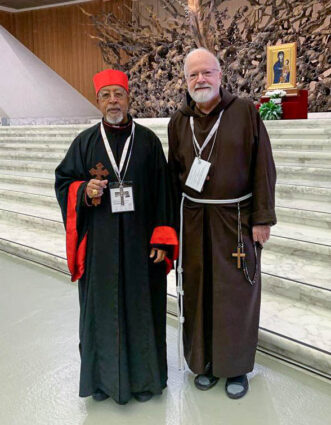
He has sent priests to work with our Ge’ez Rite Ethiopian and Eritrean community at the Cathedral of the Holy Cross. So, we took this photo together, and he asked me to take his greetings to the Ge’ez community of Boston.
I also had a chance to speak with Bishop Dariusz Kałuża and Grace Wrakia, who are representing Papua New Guinea at the synod.
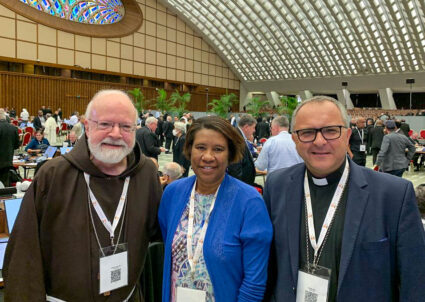
I met Bishop Kałuża when I was in PNG to ordain Bishop Don Lippert. At the time, Bishop Kałuża was the vicar general of Mendi; now, he is the Bishop of Bougainville. Grace is from Goroka, a town very close to Mendi. It’s very famous for its coffee, and she brought some as a gift for Pope Francis.
Another synod participant, Father Carlos María Galli from Argentina, presented with a copy of his book, “La Verdad Los Hará Libres” (“The Truth Will Set You Free.”) It’s a voluminous three-volume work, the first two of which are already out and the last is coming soon. It documents the whole history of the Church in Argentina during the period of dictatorship and violence between 1966 and 1993.
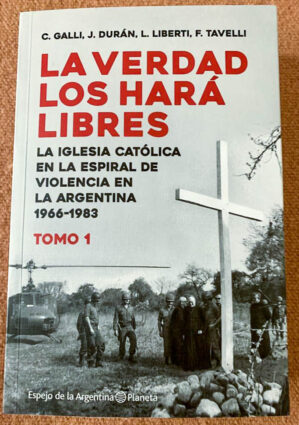
In the first volume, he has a chapter about what I sometimes call the most notorious sermon that I gave at St. Matthew’s Cathedral in Washington, D.C.
In 1979, I was celebrating a Mass for Argentine Independence Day at the cathedral that had been requested by their embassy. I had just returned from the Puebla Conference, where I had been secretary and translator for Archbishop John Quinn, the president of the U.S. Bishops Conference, and Bishop Thomas Kelly, who was secretary-general. I came back with the Puebla Document, in which there were many quotes by Pope John Paul II. One of the things that he addressed was the ideology of the national security state. So, I weaved that into my homily.
Some members of the Argentine military who were there objected (to put it lightly) and ordered everyone out of the church. So, St. Matthew’s Cathedral was vacated by the entire congregation. I was told that when the incident was reported to Cardinal Baum, he said that when Father Seán preaches at the cathedral, they should take up the collection before the Gospel!
That was a very sad period in the history of Argentina. During my first trip there, I stayed with the rector of the cathedral in Buenos Aires. The pastor’s name was Father José Keegan, who was part of the large Irish community. He and his aunt Molly, who was the housekeeper, spoke perfect English with a heavy Irish brogue, even though they had never been outside of Argentina in their lives.
He took me to the parish of the Irish Passionists, where the military had murdered all of the priests, as well as the seminarians, the retired priests, the housekeeper and her daughter. When the nuncio contacted the government, the explanation was, “It was a mistake. They were looking for the Irish Pallottines but confused them with the Irish Passionists.”
There were many such stories. I remember hearing of a Capuchin priest working in the slums who was murdered during Holy Week and of four French nuns who were tied with piano wire and dropped from helicopters into the sea. Many people were also disappeared, including pregnant women whose babies were taken from them and adopted out, unbeknownst to the families of the women who were prisoners.
So, it was a very difficult time, and the book goes into great depth to examine that history. However, I was surprised it was so thorough that they would want to include a homily given in St. Matthew’s Cathedral so far from the epicenter of the violence.
The call to welcome migrants is not just a local issue but one that resonates throughout the world. On Thursday night, at the end of our synod session, we all marched to St. Peter’s Square. There, next to the very dramatic statue, “Angels Unawares,” that depicts migrants in a boat escaping hunger and tyranny, the Holy Father led us in a very beautiful prayer vigil for Migrants and Refugees.
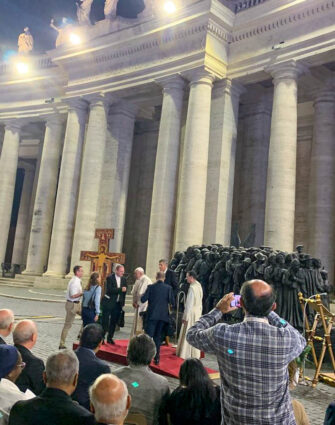
I thought the Holy Father’s homily was very powerful, and I’d like to share it with you here:
We can never be grateful enough to Saint Luke for passing on to us this parable of the Lord. This parable is also at the heart of the Encyclical Fratelli Tutti because it is a key, I would say the key, to moving from the closure of a world to an open world, from a world at war to the peace of another world. Tonight we listened to this parable thinking of the migrants whom we see represented in this large sculpture: men and women of all ages and backgrounds, and in their midst are angels guiding them.
The road leading from Jerusalem to Jericho was not a safe route, just as today the many migration routes that traverse deserts, forests, rivers and seas are not safe. How many of our brothers and sisters find themselves today in the same condition as the traveler in the parable? Many! How many are robbed, stripped and beaten along the way? They leave their homes deceived by unscrupulous traffickers. They are then sold like commodities. They are kidnapped, imprisoned, exploited and enslaved. They are humiliated, tortured, raped. And so many of them die without ever reaching their destination. The migration routes of our time are filled with men and women who are wounded and left half-dead, our brothers and sisters whose pain cries out before God. Often, they are people fleeing war and terrorism, as we are witnessing, sadly, in these days.
Today, as then, there are still those who see this, and then cross to the other side of the road; surely they come up with some reason to justify this, but in fact it is out of selfishness, indifference and fear. This is true. Instead, what does the Gospel tell us about that Samaritan? It tells us that he saw the wounded man and had compassion on him. Here is the key. Compassion is the imprint of God in our hearts. God’s style is closeness, compassion and tenderness: this is God’s style. And compassion is the imprint of God in our hearts. Here is the key. Here is the turning point. From that moment forward, the wounded man begins to recover, thanks to that foreigner who treated him as a brother. The outcome was not simply a good deed of assistance; the outcome was fraternity.
Like the Good Samaritan, we are called to be neighbors to all the wayfarers of our time, to save their lives, to heal their wounds and to soothe their pain. For many, tragically, it is too late, and we are left only to weep over their graves, if they even have a grave, or the Mediterranean ends up being their grave. Yet the Lord knows the face of each of them, and he does not forget it.
The Good Samaritan does not just help the poor traveler on the wayside. He loads him on his own beast, takes him to an inn, and cares for him. Here we can find reflected the meaning of the four verbs that sum up our service to migrants: welcome, protect, promote and integrate. Migrants should be welcomed, protected, promoted and integrated. This involves a long-term responsibility; in fact, the Good Samaritan is also concerned about returning. This is why it is important for us to be prepared adequately for the challenges of today’s migrations, understanding not only critical issues, but also the opportunities they offer, with a view to the growth of more inclusive, more beautiful and more peaceful societies.
Allow me to point out the urgent need for something else, which is not addressed in the parable. All of us must strive to make the road safer, so that today’s travelers do not fall victim to bandits. We need to multiply our efforts to combat the criminal networks that exploit the hopes and dreams of migrants. It is likewise necessary to indicate safer routes. This means that efforts must be made to expand regular migration channels. In the current world situation, it is clearly necessary to bring demographic and economic policies into dialogue with migration policies for the sake of all those involved, without ever forgetting to put the most vulnerable at the center. It is also necessary to promote a common and co-responsible approach to the governance of migration flows, which appear set to increase in the coming years.
Welcoming, protecting, promoting and integrating: this is the work we must carry out.
Let us ask the Lord for the grace to draw close to all migrants and refugees who knock at our door, because today “anyone who is neither a robber nor a passer-by is either injured himself or bearing an injured person on his shoulders.”
And now, we will have a brief moment of silence, as we remember all those who did not make it, who lost their lives along the different migration routes, and those who have been exploited or enslaved.
Until next week,
Cardinal Seán

